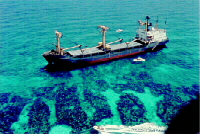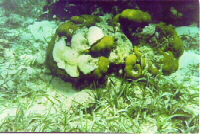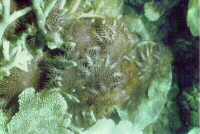We are in
serious trouble. As if our everyday challenges aren't enough -
getting chomped by a parrotfish, raked by a roving sea star, or
dizzied by a hurricane. These days we get slashed by store-bought
fins, sliced with boat anchors, and suffocated by sewage. Ours
is not an easy life, and it's not getting any easier.
If corals could talk,
that's what they might say, and this article is dedicated to
explaining why.
First, let's define coral. There
are two types of corals: those that have skeletons and build
reefs (stony corals), and those that do not (soft
corals). When you think of a coral reef, you might picture
the exotic creatures that live there like lobsters, eels, and
angelfish. But what exactly is a coral? Is it an animal, a plant,
or a rock?
Well, for reef-building corals,
the answer is all three! Corals are colonies of tiny, delicate
animals called polyps. Each polyp has a simple body structure:
a mouth, a body sac, and tentacles to capture food. Now here's
the plant part. Thousands of microscopic algae called zooxanthellae
(pronounced zoo-zan-thell-ay) live within the polyp's inner
tissues. The coral and the algae have a mutually beneficial
(symbiotic) relationship. The coral host layer provides
carbon dioxide and nutrients that the zooxanthellae use in photosynthesis,
the light-driven energy process in which plants use carbon dioxide
and water to produce carbohydrates and oxygen. The coral uses
the oxygen for respiration, and the carbohydrates for much of
its daily energy supply. Now here's where the rock part comes
in: The energy helps the coral host build its protective carbonate
(or limestone) skeleton from calcium and bicarbonate in the
seawater. Rarely growing more than a half inch per year, these
individual skeletons fuse over time to form a reef.
So how do humans alter the lives
of these unique rock-like, plant-harboring animals?
Just as we need clean air to
breathe and function properly, corals need clear, clean water
to make a living. Clear, because corals need sunlight to enable
their zooxanthellae to photosynthesize and their polyps to grow.
Clean, because too many particles in the water can smother the
polyp tissues. Unfortunately, humans do a lot to muck up the
water. Activities such as chopping down trees and dredging waterways
dump coral-clogging silt into the water. Nutrients from our
fertilizers and sewage encourage the growth of other kinds of
algae in the water above the coral that prevent light from reaching
the zooxanthellae inside.
Furthermore, one person's recreation
can mean a coral community's demise. In just seconds, careless
boaters and divers can destroy layers of coral skeletons that
took the tiny reef-builders years to create. Damage might come
in the form of a boat anchor breaking apart a coral head, or
even a careless kick from a snorkeling fin.


A huge ship splintering
the reef to pieces as it runs aground can destroy thousands
of years of growth (Photos courtesy of Walt Jaap, Florida Fish
and Wildlife Conservation Commission, Photo taken 1984, Key
Largo, foreign cargo vessel carrying animal feed grounded on
Molasses Reef). It is also a common practice in many parts
of the world to squirt poisons over the corals or explode reefs
to harvest desirable fish and reef organisms for the profitable
aquarium trade. Over-harvesting of fish and shellfish for the
seafood industry alters the complex food web of the coral reef
community.
Other threats by humans occur
over longer time scales. For example, high temperatures and
pollution are lethal to corals - they grow even more sluggishly
than normal and often become susceptible to disease (Disease
and sunscreen sidebars). And this might sound strange, but your
car is one factor in a whole suite of human-induced factors
that make the life of a coral that much more difficult. Here's
what we mean.
Corals and other reef organisms
such as clams, snails and algae build hard limestone "houses"
on top of the skeletons built by their parents, grandparents,
and so on down the family line. They build these "houses" through
a complex chemical reaction involving calcium, carbon, and oxygen.
Since the industrial revolution, we've been pumping carbon dioxide
and other greenhouse gases into the atmosphere at an unprecedented
rate by running our cars, burning fossil fuels, and clear-cutting
the forests. Many scientists believe that this is slowly warming
the earth's atmosphere and oceans. The thin veneer of water
at the ocean surface exchanges gases with the atmosphere in
a two-way process; therefore, increasing the concentration of
greenhouse gases in the atmosphere ultimately changes the chemical
composition in the water. Because carbon dioxide is a weak acid
when dissolved in water, when we increase the concentration
of carbon dioxide in the atmosphere we actually make the oceans
more acidic. The corals have a tough time in this type of environment
and must use up more energy just to maintain their skeletons,
let alone build them.
Furthermore, as greenhouse gases
heat up the planet like an electric blanket that's always on,
more polar ice caps melt, which adds water to the oceans and
raises sea level. This makes it tough for reefs to grow fast
enough to keep up.
Recall that reef-building corals
are part plant. The tiny zooxanthellae need sunlight to make
energy via photosynthesis. Also recall that a coral reef is
essentially composed of "life over death" - the living coral
polyps live on top of the older rocky fossils left from prior
generations. The top layer of a coral reef must stay within
the uppermost layer of water through which sunlight penetrates
(euphotic zone). Therefore, if sea level rises the slow-growing
corals will begin to slip below the euphotic zone and essentially
"drown."
The phenomena of sea level rise
and reef "drownings" are not new. Historically they have occurred
as natural events unrelated to human activity. Paleoceanographers
(marine scientists who study fossil reefs), can point to countless
examples of sea level rise and reef drownings in the fossil
reef record (See sidebar on paleoceanography at bottom of article).
However, tomorrow's paleoceanographers may classify the current
global warming as anthropogenic (man-made) because of
the tremendous amount of greenhouse gases released by human
activities today.
It's not all gloom and doom
though! With more education and better management practices,
we can curb the dramatic toll we are taking on coral reef communities.
It's in our best interest to do so. Coral reefs are diverse,
beautiful communities that not only decorate the marine environment,
but are integral in sustaining its health. For example, reefs
serve as nurseries for populations of finfish and shellfish;
they act as a breakwater, protecting sensitive shorelines; and
they produce large amounts of sediment (sand) for beaches. Many
mysteries in the intricate life of a coral reef have yet to
be uncovered. They may even help save our lives! Just like rainforests,
coral reefs may contain the cures to many of today's and tomorrow's
illnesses. For example, coral is now used for bone grafts, and
extracts from a host of reef organisms are being tested for
their potential to fight the growth of tumors.
So consider passing along the
coral's message the next time you discuss coral reefs in science
class. Yes, they can live without us, but we wouldn't want to
live without them.
Sunscreen
sidebar: SPF - It's not just for humans anymore


Corals can get sunburned
in the water just like people. We apply lotion to prevent getting
burned, but corals can't exactly run down to the corner store
to buy some sunscreen. What's a coral to do? They make their
own!
Although not well understood, the plant
part of the coral is believed to manufacture mycosporine-like
amino acids (MAA's) that are transparent to visible light, but
absorb ultraviolet (UV) light. This enables the zooxanthellae
to photosynthesize all day long without having their photosystems
(where photosynthesis takes place) damaged by the nasty UV rays.
Corals that live at shallow depths where there is more UV light
penetrating the surface produce more MAA's than those that dwell
deeper. It's interesting to note that high water temperatures
can cause MAA's to degrade. This leaves the coral with less
protection against UV rays and a greater chance of bleaching,
which occurs when the zooxanthellae that give the coral its
color are expelled from the coral so they look whitish. (Photos
of bleached coral courtesy of Melanie Dotherow, University of
South Florida)
Disease sidebar: Stress
and disease in corals
The health of coral reefs is
declining on a global scale.
• Many coral diseases
such as black-band disease, characterized by black bands containing
bacteria, cyanobacteria (blue-green algae) and fungi that spread
over a coral and leave only the limestone skeleton behind, can
kill living coral polyps on a reef.
• Coral bleaching events
have been linked to periods of high water temperature, calm
winds and high solar radiation (particularly UV light) which
cause the coral to expel its zooxanthellae.


• Crown of Thorns Starfish,
which dine on the live coral polyps, can decimate the living
coral veneer as they migrate over the reef. Invasions of this
coral predator are an increasingly common occurrence in the
Pacific Ocean. In the photographs, observe how the starfish
are advancing on the greenish coral from Palau; the bright white
area is where the starfish have eaten off the living coral tissue.
(Photos courtesy of Charles Birkeland, University of Guam)
Paleoceanography sidebar:
History of the Deep
Did you know that major coral
reefs once flourished where Texas, Michigan and Pennsylvania
are now located? And at one time when sea level was much lower,
Native Americans in western Florida lived along shorelines that
are now underwater in the Gulf of Mexico! Paleoceanographers
figured out why old reefs are found on top of mountains or deserts
today, and why ancient shorelines are now submerged. They study
the development - or history - of the world's oceans using sediment
layers and fossils as clues to what the earth used to be like.
For instance, geologic records (sequences or cores of sediments
studied by paleoceanographers) indicate that no pre-Cambrian
organisms were made of carbonate whereas today there are lots
of carbonate-bearing organisms in the oceans. This tells us
that the pre-Cambrian ocean environment was very different chemically
than it is today.
Breaks in the geologic record
(hiatuses) point to sudden and dramatic changes in the earth's
climate or ocean circulation. But remember that geologically
speaking, "sudden" changes might occur over thousands - or even
millions - of years! These changes wipe out certain types of
animals and allow others to flourish. Hiatuses are also clues
to catastrophic events in the history of the earth. Please praise
paleoceanographers profusely for pinpointing our planet's prolific
pebble profiles! (Photo courtesy of Pam Hallock-Muller, University
of South Florida; Photo shows the site of a former coral reef
slope, Canning Basin, Western Australia, Sindjana National Park)

